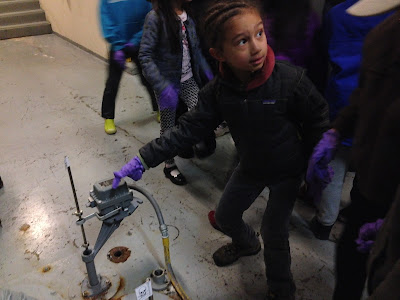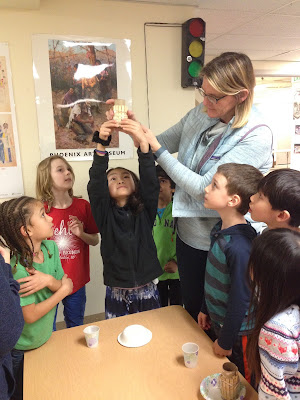The Navigators and Pioneers faced many engineering challenges while making the 2200 mile Oregon Trail trek. Divided into wagon groups of 4-5 students, the travelers met each challenge with determination, grit and passion. And, along the trail, learned how to work together as a wagon unit.
Challenge #1
Build a wagon that will hold the most weight.
Use only the supplied materials: cardboard, toothpicks, chenille wires, straws, tape and glue.
We eagerly began to work and soon the room became very loud...very loud because everyone had their own idea of what needed to happen and everyone wanted to have their own ideas heard!
We used water bottles to test for weight capacity. One group's wagon wasn't off the table to start with (not pictured), another group's fell over immediately, another group's held a couple of bottles and one group's held 2...3....4...5...6+ bottles!
Challenge #2
Make a raft that will keep a covered wagon afloat.
Use only the supplied materials: 12 tongue depressors, 1 yard yarn, 1 yard tape and glue.
This time we circled the wagons and talked about what worked for the first challenge and what didn't. We all decided that we need to listen better to each other. So we each drew up our own plan, took turns showing our fellow wagon-mates our plans, came up with a group plan and then decided how we were going to get the group plan accomplished. When we began to work the chatter in the room was purposeful and happy.
We again had mixed results when we tested our rafts in water but we had learned a much more important lesson--collaboration.
At the end of the testing, we circled the wagons again and talked about how much better this engineering challenge went and why.
Challenge #3
Build a temporary lean-to that will keep your paper family of travelers safe and dry in case they need find shelter from a storm.
Use only the supplied materials: a variety of branches and twigs.
The challenge was quite the challenge, especially with the slippery tables. But we faced it with our learned collaboration skills and our innovative imaginations.
When finished, we circled the wagons and this time talked about the pros and cons of each design and voted on the one that we thought was best.
Challenge #4
Build a barrel that will hold water.
Use only the supplied materials: 8 clothespins, 1 toilet paper roll, 2 rubber bands, 1 foot of string, 1 3" X 3" piece of plastic baggie, cardboard, glue
This time we each made our own barrel. It was a bit difficult to get started, but then one or two got great ideas and others noticed (we say it's okay to copy!) and soon all were on their way to making a barrel that would hopefully hold water.
The finished barrel designs:
Time to test. Most of the designs held water. The biggest surprise was the barrel that didn't have the plastic on the bottom held water. We think it's because the bottom cardboard fit well and the clothespins were glued close together.
Time to have the wagon teams circle the wagons again!
Another engineering lesson learned--we can learn from our successes and failures and from the successes and failures of others.
Future coopers of America!?












































































